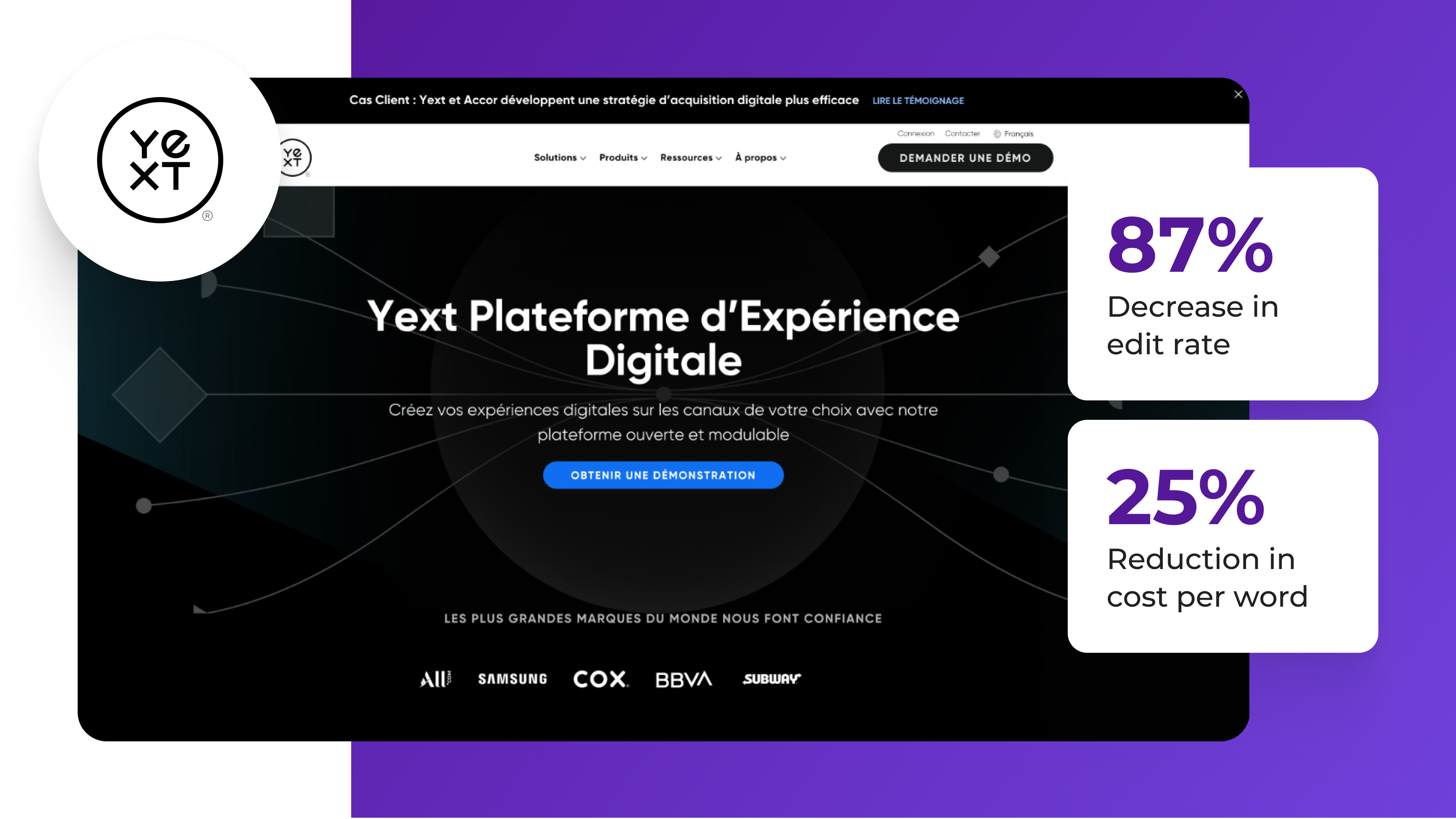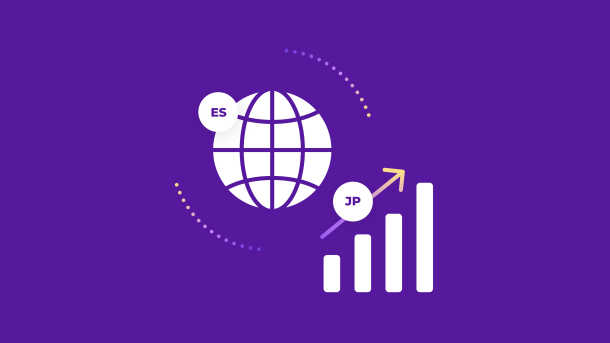Global expansion, for many businesses, is a huge growth catalyst and focus for the coming years. Enhanced connectivity and digital transformation, coupled with an ongoing trend toward remote workforces, have opened the world up to many companies.
There’s just one piece of the puzzle left to solve: the language barrier.
Sure, a US-based business can easily expand into Canada, Australia, and the UK with just a few spelling changes to existing English content. But expanding into Europe means translating your entire business into different languages, such as Spanish, German, French, and more.
Business translation, as this process is known, is of critical importance. In this article, we’ll show you how to get it right.
We’ll explain the case for business translation services and even show you internal resources that are dedicated to translation projects. We’ll also detail the different kinds of documents and assets you’ll need to translate in order to effectively engage in international business.
The case for business translation
Established enterprises may use expansion as a means of growing revenue and improving stock prices. Smaller companies in more competitive markets might choose to target international markets, where the likelihood of owning a significant market share is higher.
Whatever the goal, in order to successfully move into international markets, you must accurately translate your business’s existing content into the local language. You’ll also need to adjust aspects of your business, such as pricing or commonly accepted payment methods, to the local expectations of the region you’re expanding into.
First, though, you’ll need to ensure that potential customers can understand important, high-visibility assets, such as your company website.
The challenges of international business communication
Let’s walk through a scenario.
Your company is looking to expand into a new target market to reach customers in Latin America. The first step is using a translation service provider to translate your existing website from English to Spanish and Portuguese.
But you have different dialects to consider. While Mexico, Colombia, Peru, Argentina, and Chile all speak Spanish, each has subtle dialect differences, which can make translation more complicated (each country has its own word for popcorn, for example).
To accurately translate content for each region, it is important to work with local linguists in each market to make sure your content resonates with the local dialect. And since you’ll be serving customers in each of these countries, you’ll also need customer support reps who can accurately respond to and support your customers. They’ll need access to your technical documents, like user manuals, translated into the local language.
As you can see, your website is far from the only asset that falls under the business translation umbrella. Let’s explore what else you’ll need to translate.
Types of translation in business
You can divide most business translation projects into one of four categories:
- Digital assets
- Legal assets
- Technical assets
- Internal assets
Let’s look at each in a little more detail.
1. Digital asset translation
This is the principle task that comes to mind when we think about business translation.
Digital asset translation involves translating marketing materials like your website, social media content, blog posts, and ad copy, as well as sales collateral and email copy.
Most of your customer-facing documentation and anything related to your global marketing strategy will fit into this category.
Get the guide: Tips and examples for boosting your global marketing strategy.
2. Legal asset translation
Next up is translating legal documents, which include:
- Customer contracts
- Employment agreements
- Documentation related to compliance standards like SOC 2
When engaging in this type of business translation, be sure to choose a reliable legal translation service that offers subject matter expertise, maximum security, and data privacy guarantees.
3. Technical asset translation
Technical translation covers documentation like user manuals, customer support articles, and guidelines for using application programming interfaces (APIs). If your company uses whitepapers and other technical documentation as part of its customer acquisition strategy, these materials might also fit into this category.
Some companies may also need to translate business documents related to intellectual property, such as patents or research papers.
4. Internal asset translation
Finally, there’s everything that fits into the internal asset bucket.
This includes documentation such as:
- Annual reports
- Processes, procedures, and workflows
- Corporate style guides
- HR manuals
Internal asset translation is critical for empowering remote teams in new locations to adhere to existing guidelines and for promoting consistency across the entire organization.
Strategies for successful business translation
Ready to dig into your translation project? Here are five powerful strategies for effective business translation:
1. Centralize your assets
Whether you choose to handle document translation in-house, outsource to a translation company, or work with a handful of freelancers, centralizing your assets in one place will be critical for ensuring efficient workflows.
Document storage solutions like Google Drive are a reasonable start, but for high-volume enterprise business translations, a translation management system (TMS) is the best move.
Your TMS acts as a central hub where you can store all your translated assets and manage your translation program. It's a collaborative, searchable, and centralized workspace for project managers, translators, and anyone else involved in the translation process.
You can also integrate your TMS with existing systems to speed up workflows.
2. Integrate with your existing software architecture
Software integrations and connectors can significantly improve workflows and enhance turnaround time.
With your TMS connected to your website content management system and your marketing automation tools, you can create automated workflows that help improve your time to market while expanding into new languages.
Get the ebook: A Translation Solution that Grows with Your Content.
3. Engage AI-powered human translation services
A common debate when beginning a business translation project is whether to engage professional human translation services or take advantage of a modern AI-powered machine translation (MT) tool.
Both have their benefits. For example, AI software allows you to scale and produce more translations quickly, while human translation services allow you to tap into industry experts who are familiar with your subject matter’s nuances. Both options leverage linguistic assets such as glossaries (a document that contains brand-approved, pre-translated phrases and terms) and translation memory (a bank of previously translated content) to improve consistency and quality.
Our take? Get the best of both worlds with AI-powered human translation.
Smartling’s AI-powered human translation service uses your brand’s glossary terms and translation memory to translate content through our multi-engine approach. Then, our expert linguists perform a human review in context to ensure accurate, high-quality translation.
4. Use local native speakers
Consider the differences in how people speak English in the US, New Zealand, Canada, and the UK. Beyond differences in accents, these countries also use different dialects, slang, and idioms, and you’ll even find differences in territories within these countries.
For example, a marketing campaign that uses the phrase “Chur, bro” might go down well in New Zealand but would go over the heads of a US audience.
This illustrates the importance of native speakers in business translation. Where possible, look for translators who are fluent in the local dialect of the region you’re targeting.
5. Consider formatting, design, and user experience
Finally, consider how translation might require changes to design, layout, and user experience across business assets.
For instance, a paragraph in English that contains 5,000 total characters could come out with as few as 1,400 characters after you translate it to contemporary Chinese. This could have a major impact on how you might design a marketing asset.
Materials in languages like Hebrew and Arabic, which are written from right to left in contrast to English’s left-to-right orientation, will also look different from the source material. Translating into one of these languages may even require a complete design overhaul.
Case study: A business transformed
So what does a good business translation project look like in practice?
Let’s explore how Yext, working with Smartling’s professional translation services, helped to support international teams around the world with high-quality translations.

When Yext launched its Japanese go-to-market initiative in 2018, scale was a challenge. The company clearly had a lot to translate, from marketing materials to its web app, as well as its entire customer-facing website. But Yext only had one marketer in Japan, which meant that the solution had to be a scalable and repeatable workflow integrated into Yext’s existing software stack.
To achieve this, Yext:
- Invested up front in linguistic assets, such as a style guide and a glossary
- Centralized assets in Smartling’s TMS
- Integrated Smartling with its website via API
- Focused on developing a large translation memory to boost future translation efficiency
The result? Between 2018 and 2020, Yext reduced its cost per word by 25% using translation memory and workflow integrations. The company also created an 87% decrease in the number of words its teams edited using linguistic assets.
Get the Yext case study: How Yext Translated 12 Million Words to Support Teams Around the World.
Expand your business horizons with Smartling
To effectively break into international markets, you’ll need a process and workflow to convert both existing and newly created content into the languages and dialects that your target audiences speak.
There are several ways to accomplish this: a single project manager who oversees various freelance translators, a fully integrated MT solution, or a translation agency.
Then, there’s the best of both worlds: Smartling’s AI-powered human translation services.
By combining professional human translation services with a best-in-class, AI-driven translation suite, you can navigate translation difficulties at scale without compromising efficiency and affordability.
Watch our five-minute video demo to discover how Smartling can transform your global business expansion strategy.








